Stargazers and lovers of the night sky will love exploring the Dark Sky Parks found in the USA and around the world!
This post contains affiliate links for which Expedition Wildlife may receive a commission (where applicable) at no additional cost to you.
Did you know there are designated Dark Sky Places around the world?
These places include Dark-Sky Communities, Reserves, Parks, and Sanctuaries, all of which are known for being locations where the night sky is brightest and stargazing is best.
Stargazing isn’t the only goal, however.
Why Do We Need Dark Sky Parks?
The International Dark-Sky Association, first established in 1988, works to reduce and eliminate light pollution worldwide.
Light pollution doesn’t just block out those incredible stars and night skies, but it also impacts wildlife behavior, our health and safety, and our wallets.
- Animals, including birds and sea turtles, depend on natural light for migration and directionality. Bright lights from towns, neighborhoods, or streets can disrupt those natural processes. Newly hatching baby sea turtles, for example, look for the light of the morning sun to find the ocean. Artificial lights lead them in the wrong direction and have negatively contributed to their population decline.
- As blue-light glasses are now a common Amazon purchase (I also own a pair), and nighttime settings on phones are frequently set, more people are aware of our Circadian rhythm and how unnatural, blue and white light negatively impacts our sleep cycle and strains our eyes. Now multiply that blue and white light over a whole city!
- It’s not new information that leaving lights on when they aren’t in use wastes energy, and thereby, money. The IDA is working to educate communities about *correct* lighting, not just overlighting, to save energy and enhance street safety efforts.
We asked our fellow bloggers to share with us one of their favorite, must-visit Dark Sky Parks in the USA.
Get out to one of these beautiful sites, or others around the world, to enjoy some stargazing splendor!
Big Bend National Park, Texas
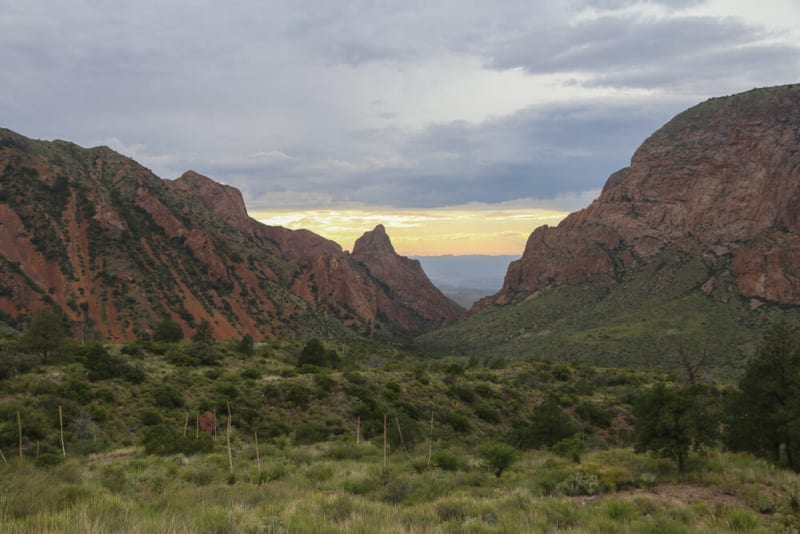
Contributed by Erin of Sol Salute
Visiting Big Bend National Park is to leave the city behind, far behind. If you’re coming in from out of state, fly into the closest city of El Paso, which is a 5-hour drive from the park.
This isolated park may be hard to reach but it’s worth every bit of effort, and the crisp, non-polluted night sky will be your reward. To see the milky way in all its glory, make sure to visit when there’s no moon. This area of Texas is extremely hot during the summer so it’s best to visit between September and April. School holidays can get very crowded so try to avoid major days like Thanksgiving.
The absolute best way to stargaze in Big Bend is by camping at one of the many backcountry campsites. If you’d rather sleep with more creature comforts, rent a room at the Chisos Mountain Lodge. This is the only hotel within the park and its privileged location in the Chisos Basin is just steps from the best hikes in Big Bend. The lodge also has some of the best views for the sunset and of course, stargazing.
Read more here about how Big Bend is one of the best birding destinations in the USA!
Joshua Tree National Park, California
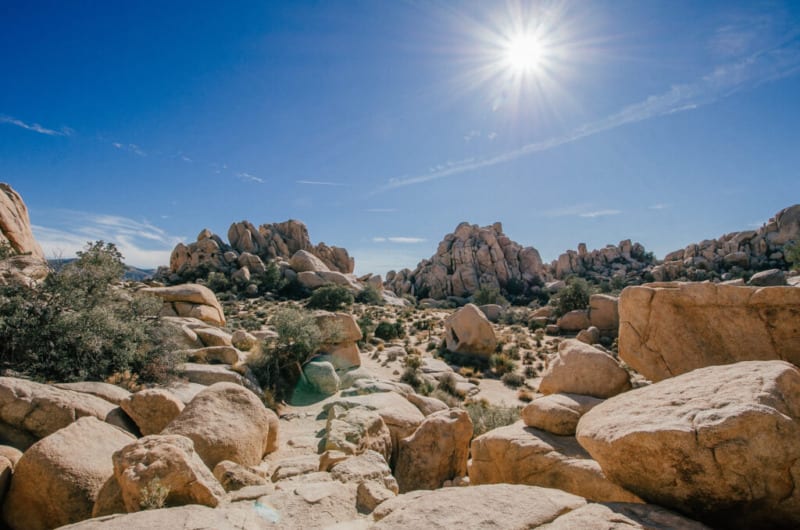
Contributed by Abi of Happy Go Abi
When looking for beautiful places to go stargazing, Joshua Tree National Park should definitely be on your list. This gorgeous Dark Sky Park is the perfect place to visit and stargaze on a one day trip, or to stay longer and enjoy looking at the night sky all night long.
When planning your trip, you’ll discover that the best way to explore this park (especially if you want to stay around and see the stars at night) is to drive. And remember that you’ll get the best views of the sky when visiting around the new moon and on a clear night. Other things to keep in mind include visiting during fun astronomical events and seeing the Milky Way more easily in the summertime.
And once you’re in the park? Well, the entire park is amazing for viewing the night sky, so you can go anywhere and get stellar views! If you’re just visiting for the day, the roadside pullouts can actually be amazing stargazing locations. However, it is true that some parts of the park are darker than others…so many people love staying the night at one of the park’s campgrounds and stargazing there.
Other locations you may enjoy stargazing from include some iconic Joshua Tree formations, like Skull Rock and Arch Rock. These are excellent locations to take some amazing pictures if you are a photographer. But no matter where you stargaze from, a visit to Joshua Tree National Park to see the stars is unforgettable!
Anza-Borrego Desert State Park, California
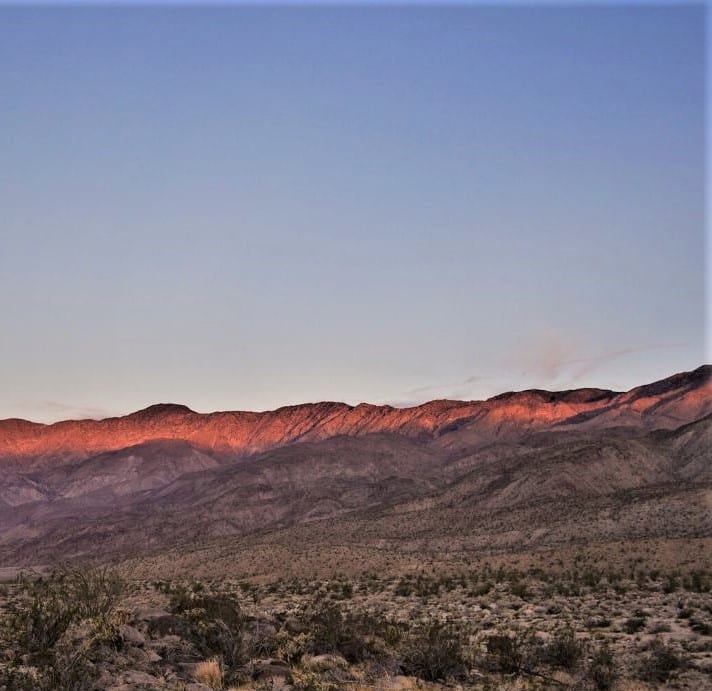
Contributed by Monica of This Rare Earth
Anza Borrego Desert State Park sits roughly two hours east of San Diego, CA. As the largest state park in the lower 48 states, Anza Borrego offers an endless option of landscapes to explore, from cactus-covered hillsides to rocky terrain to unexpected slot canyons to climb through. Wildflower season brings visitors from far and wide, wanting to see the purple and yellow blooms in the dry desert.
Though not exceptionally well-known outside of the state, Anza Borrego is among some of the most interesting and awe-inspiring desert parks of Southern California.
Another huge draw is the opportunity for fantastic stargazing. If you’ve never seen the dark sky filled with thousands of glowing stars from the middle of the desert, add this to your bucket list. Gazing at the night sky minus all of the light pollution from nearby cities is phenomenal. On exceptionally clear nights, it is even possible to see the Milky Way.
Some of the best spots for stargazing in Anza Borrego are the Fish Creek Primitive Campground (4WD recommended) and the Blair Valley Primitive Campground (2WD okay). Much of the State Park is free to enter, as it is labeled public land. However, a few spots charge a nominal fee for day use.
Grand Canyon National Park, Arizona
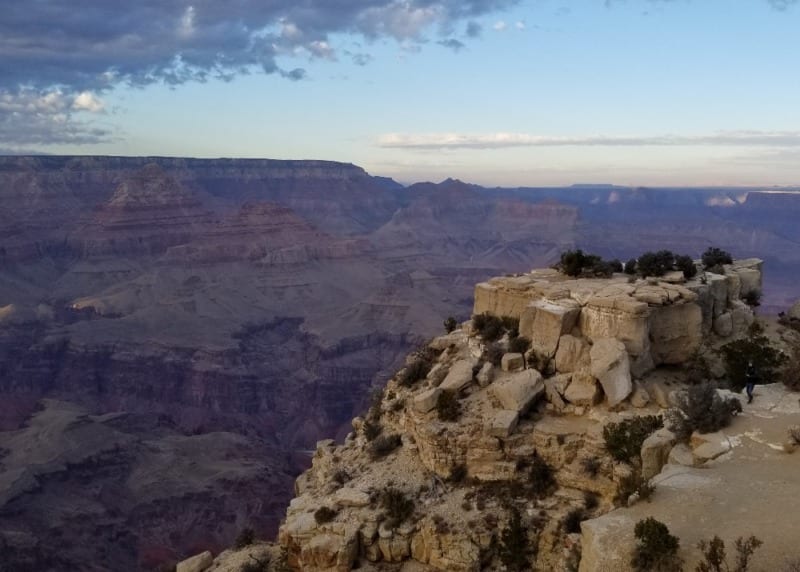
Contributed by Eden of Rock a Little Travel
One of the most impressive Dark Sky Park locations in the United States is in the American southwest at Grand Canyon National Park.
The Grand Canyon received its official Dark Sky Park certification in June 2019, making it a popular destination for both stargazing and Astrophotography.
Some of the best spots for viewing the night sky along the South Rim can be found by taking a short road trip out to the Desert View overlook at the eastern edge of the park, or any of the other overlooks along the southern rim.
For visitors to the North Rim, head to the overlook near Bright Angel Point Trail or Walhalla Plateau.
The best time to visit and enjoy the Grand Canyon’s dark skies is from April to June when you’ll have less cloud cover, or between November and January when the nights are longer.
Grand Canyon National Park is located in northern Arizona just south of the Utah border. The nearest major city with an airport is Phoenix, which is a short four-hour drive away.
For visitors looking for a place to stay, consider booking a room in advance near Grand Canyon Village at either El Tovar Hotel or Yavapai Lodge.
Arches National Park, Utah
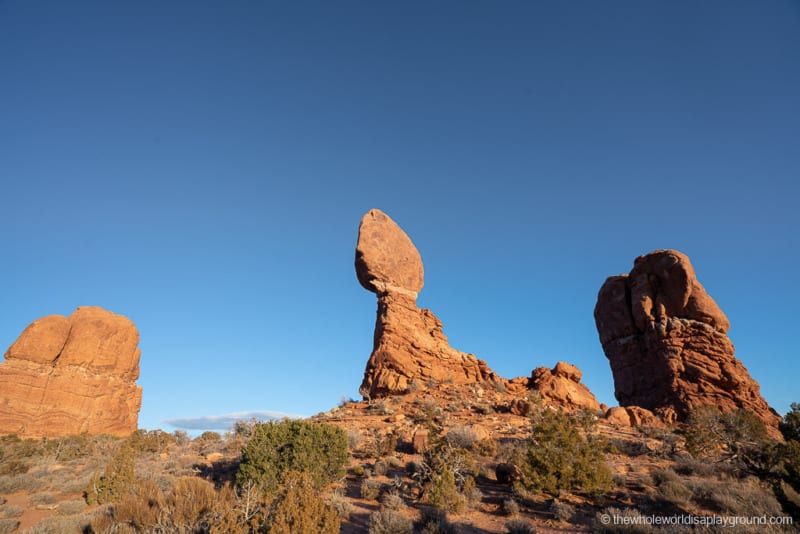
Contributed by Elaine of The Whole World is a Playground
With its crystal clear night skies, Arches National Park in Utah is a must-visit Dark Sky Park in the USA. The best stargazing spots are found by driving north, away from the town of Moab and its lights. Balanced Rock, the Windows, and the Panorama Viewpoint are all great options for observing the glittering night sky.
Arches is also home to over 2,000 natural stone arches along with a variety of hiking trails and some fascinating rock formations. Delicate Arch, which appears on Utah license plates, is one of the most popular trails. Other highlights include Landscape Arch and Devil’s Garden, Balanced Rock, and the Windows.
Devils Campground is the only option for in-park accommodation. Most visitors to Arches stay in the nearby town of Moab where the Springhill Suites and Fairfield Inn are both great options close to the entrance. Moab also provides easy access to the nearby Canyonlands National Park.
Salt Lake City is just under 4 hours drive and Las Vegas is a 7-hour trip. A visit to Arches is often combined with some or all of Utah’s other National Parks. Together with Arches National Park, Bryce Canyon, Zion, Canyonlands, and Capitol Reef National Parks are all part of Utah’s incredible ‘Mighty Five’.
Capitol Reef National Park, Utah
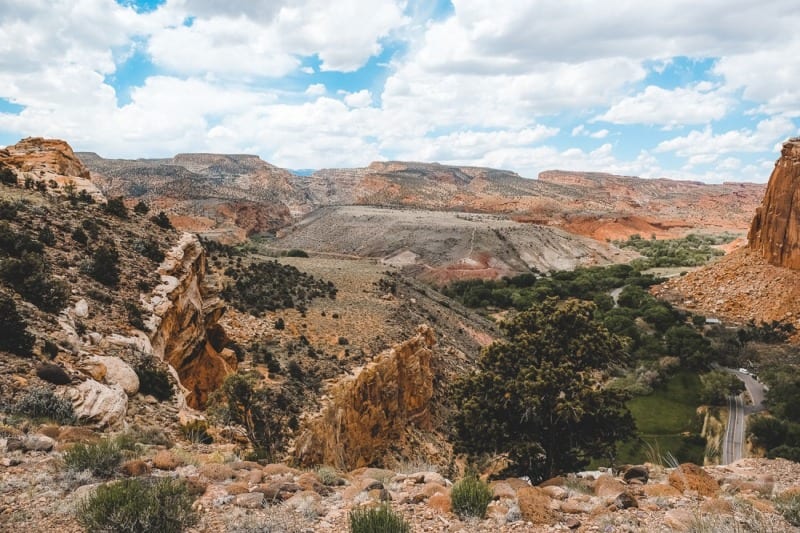
Contributed by Megan of Red Around the World
Capitol Reef National Park is the most underrated park in Utah with some of the best stargazing in the state.
It’s the perfect stop between Moab and Zion, which most people skip or just drive right through. Spend a night or two here to really experience all it has to offer, day and night. Camp in the park if you can. However, if you want a little more comfort, the bed and breakfast in Torrey is wonderful (and my favorite). The best camping experience you could have for stargazing would be on the Cathedral Valley Loop Road. If you don’t have a vehicle that can make it, the main campground will still be great.
There aren’t any bad stargazing spots here, but the most open areas are optimal. The Goosenecks Overlook, Sunset Point, Hickman Bridge (involves hiking), and the North Fruita Overlook (involves hiking) all offer wonderful unobstructed views.
The park also offers night sky ranger-led programs, so check at the visitor center to see their schedule. There is no bad time to visit, but it can get cold in winter and windy in spring. Fall is my favorite. If you visit in late summer/fall you may be able to pick fruit in the orchards during the day.
After living just a short drive from the park for most of four years, the number of stars and view of the Milky Way out here still blows my mind.
Black Canyon of the Gunnison National Park, Colorado
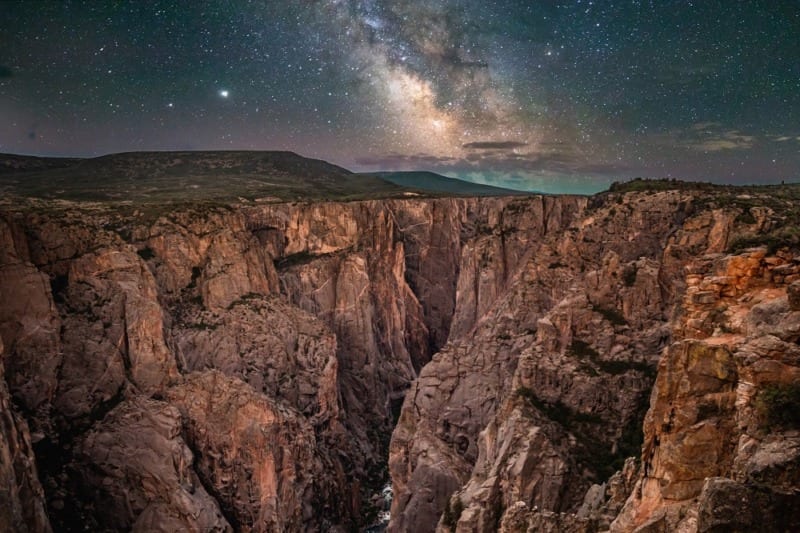
Contributed by Dalya of Sweet Little Journey
Black Canyon of the Gunnison National Park is located in Southwest Colorado and has some of the clearest dark skies in the country. It’s over 4 hours away from the closest international airport and is so remote that it’s one of the top 10 least visited National Parks in the country. This, along with the lack of hotels or accommodations outside of camping, helps immensely in keeping light pollution to a minimum.
Black Canyon of the Gunnison officially became an International Dark Sky Park in 2015. This park is accessible year-round and open 24/7. You do not need a permit to enter and there are so many viewpoints for seeing the night sky.
The park has two entrances – the South Rim Visitor Center and North Rim Ranger Station. These two entrances are 1 hour and 40 minutes’ drive apart, so you’ll need to plan ahead for which side of the park you want to explore on a given day. Some notable points are Painted Wall and Chasm View on the South Rim, and Exclamation Point on the North Rim.
For exploring the North Rim, stay in Crawford. This is the closest town to the North Rim Ranger Station and has several great Airbnbs and lodges to spend the night. If staying in the South Rim, you can stay in the nearby city of Montrose, or pick one of the three campsites inside Black Canyon of the Gunnison.
Cherry Springs State Park, Pennsylvania
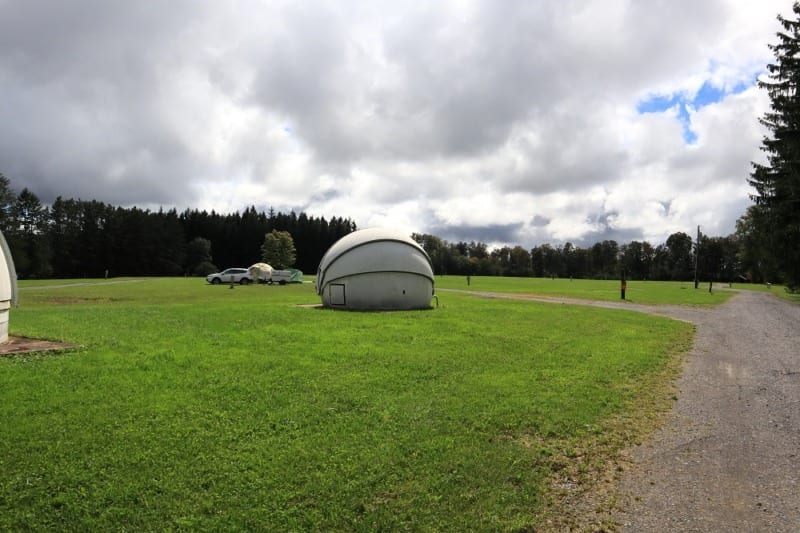
Contributed by Pam and Katherine of Everywhere Forward
If you’re looking to see some of the darkest skies in Pennsylvania, visit Cherry Springs State Park!
Located in the heart of the Pennsylvania Wilds region of the state, Cherry Springs State Parks attracts thousands of stargazers year-round. When conditions are right, Cherry Springs offers a spectacular view of the Milky Way. Cherry Springs is most popular during the summer months, especially during meteor showers. Cherry Springs also hosts star parties throughout the year and the annual Woodsmen’s Show. During a visit to Cherry Springs, don’t forget to pack red covers for your lights and a telescope or binoculars!
Cherry Springs has two areas for dark sky viewing. The Overnight Astronomy Observation Field is designated for campers, while the public viewing area is for nighttime visitors. If you’re not camping at the state park, there are plenty of nearby, local campgrounds in and around Coudersport. There are also multiple locally run hotels in Coudersport as well.
Death Valley National Park, California
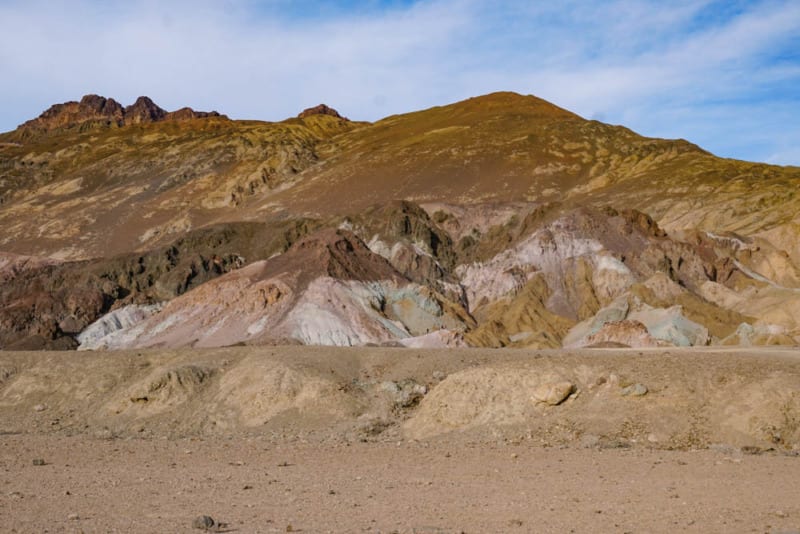
Contributed by Dhara of Roadtripping California
Stargazing is one of the best things to do in Death Valley National Park! As a Gold Tier Dark Sky park, Death Valley boasts some of the darkest skies in the country. This makes it a fabulous destination not only to view heavenly bodies, but also to practice your night photography skills.
Within Death Valley National Park, you’ll want to drive to an elevated place. This makes sure your view of the Milky Way is not blocked by surrounding mountains. Harmony Borax Works, near the Furnace Creek Visitor Center, is both elevated and easily accessed. Further in the north of the park, the area near Ubehebe Crater features the darkest skies within the park.
But really, you could just drive and park off the road anywhere in the park, and you will be treated to millions of stars on a clear no-moon night! Just be careful where you step though, as the desert is home to rattlesnakes and the like.
The park holds special Dark Sky events in the winter and spring. Joining one of these ranger-led events is a great way to learn as you observe. Winter and spring, along with late fall, are also the best times to visit Death Valley.
Stay in one of many campgrounds in Death Valley, or stay at the Ranch at Death Valley, an affordable hotel inside the park.
Bryce Canyon National Park, Utah
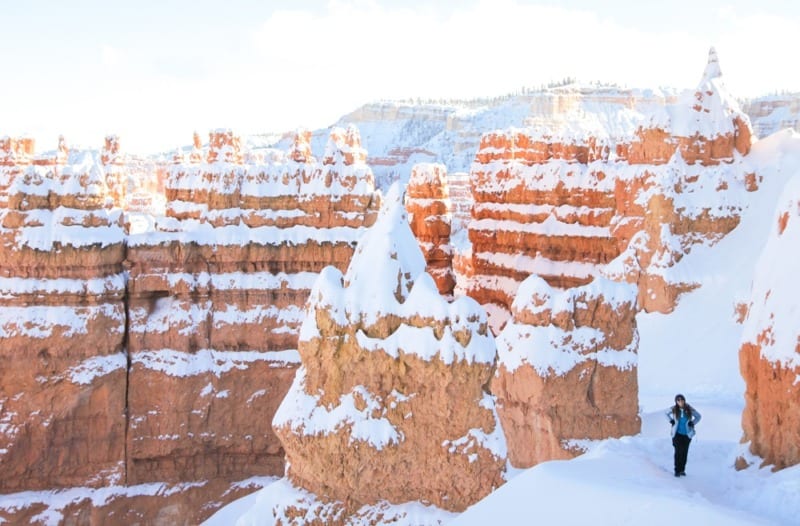
Contributed by Jenny of Campsite Vibes
Bryce Canyon is a beautiful and underrated park. I visited in November right after a snow storm and it was a winter wonderland. The best time to visit Bryce Canyon is in the fall or spring months when the weather is not too hot. This is also when more trails are open. If you want to experience a winter wonderland that hugs the bright red and orange rocks, then winter is a great time to visit as well.
Bryce Canyon is generally easy to get to, compared so some other national parks. There are a variety of hotels right outside of the park. If you’re looking to camp, there is the North Campground which is first-come, first-serve and part of it is open year-round. There is also the Sunset Campground which is closed in the winter, first-come, first-serve in the spring and fall months. This campground is also open for advanced reservations in the summer months.
For the best stargazing, go to Inspiration Point, Sunset Point, and Sunrise Point which give you a nice view over the Bryce Amphitheater. You can also go to the Natural Bridge Overlook so you get to admire the stars over and under the natural bridge.
Great Sand Dunes National Park, Colorado
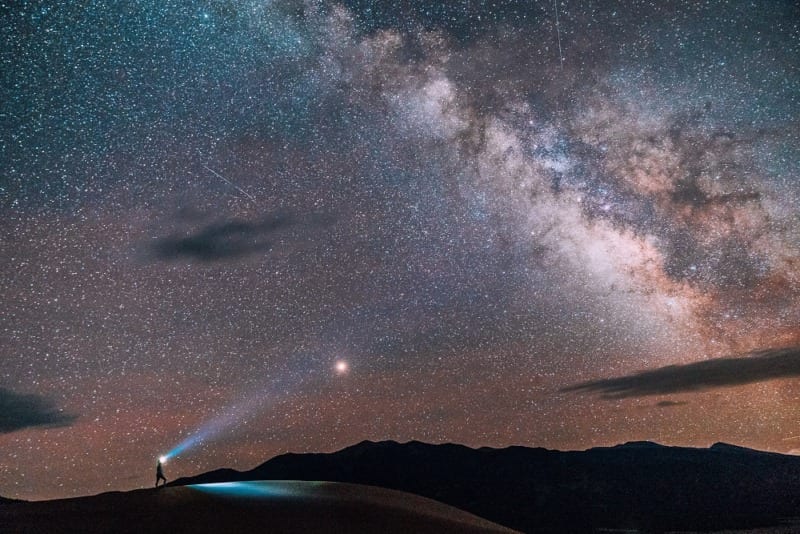
Contributed by Meg of Fox in the Forest
For a truly unique dark sky experience, head to Great Sand Dunes National Park in Colorado. Located just 30 minutes from the small town of Alamosa, this stunning national park features the largest sand dunes in North America. The sand actually bubbles out of a spring that is sacred to the Native Americans who once inhabited the lands nearby.
Although you can’t visit the spring, if you stay at Great Sand Dunes National Park from April through May, you can swim in the water at the base of the dunes. One must-do hike is the Star Dune, touted as one of the best hikes in Colorado, which takes you to the top of the sand dunes. Hike during sunset for an epic view of the night’s sky. The Milky Way lights up the inky night’s sky for an incredible view you’ll never forget.
Soak in the sunset as you hike up the dunes with the mighty Sangre de Cristo Mountains as a backdrop.
Most people opt to camp at either the paid campground just outside of the national park (reservations recommended) or the campground within the national park (first-come-first-served). Alternatively, you can stay in nearby Alamosa or even head over to Westcliffe and check out the community’s dark sky observatory.
Pickett State Park, Tennessee
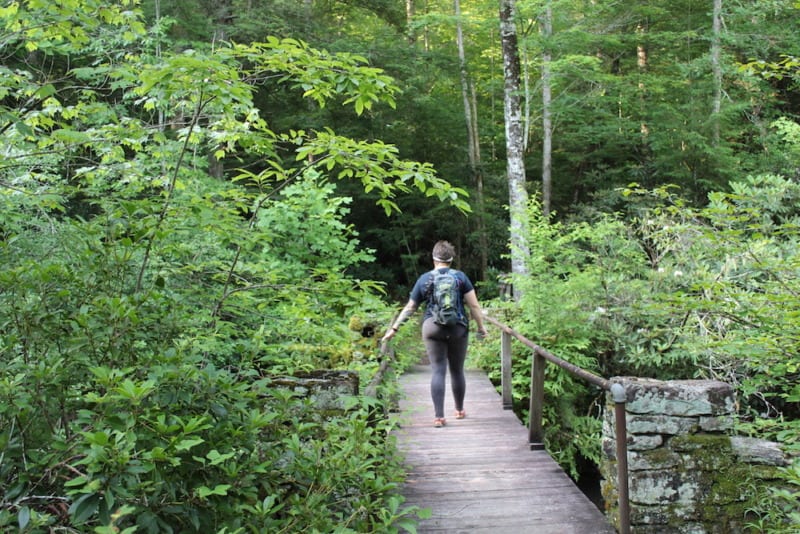
Contributed by Ashley of Wild Hearted
Pickett CCC Memorial State Park is nestled in an unassuming area of north-central Tennessee. It’s approximately 2.5 hours from Nashville and less than two hours from Knoxville. Following I-40 most of the way from either direction and GPS will lead you right to it!
In 2015, Pickett CCC Memorial State Park earned the Silver-tier International Dark Sky Park designation, becoming the first state park in the Southeast to do so. You can enjoy the skies on your own or through a night sky viewing event held by the park during summertime.
In addition to the Dark Skies, Pickett offers a museum with interpretative exhibits, rustic and suite cabins, campsites, 58+ miles of hiking trails varying in difficulty and length, natural bridges, sandstone bluffs, waterfalls, and optimal wildlife viewing – even black bears!
Copper Breaks State Park, Texas
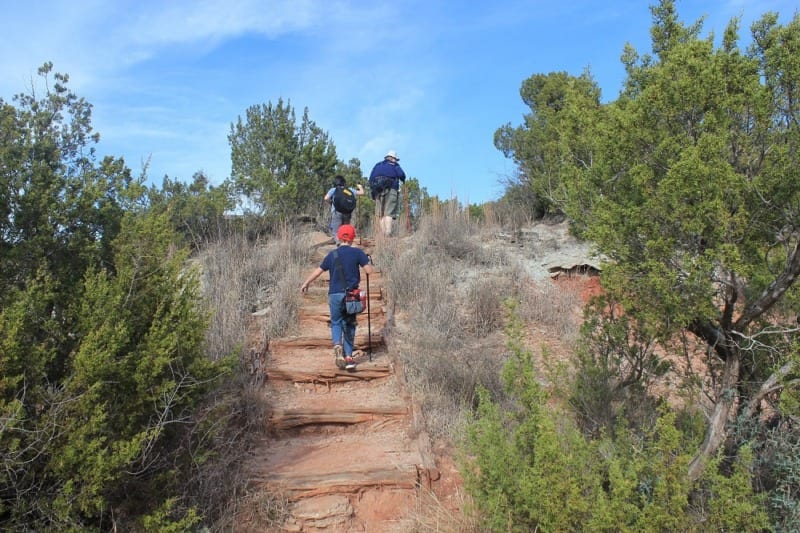
Contributed by Umiko of Two World Treasures
Texans are fortunate to have four state parks and one national park that are certified IDA Dark Sky Parks. One of them is Copper Breaks State Park, located in Quanah, in Hardeman County. It is about 3,5 hours drive going northwest from Dallas towards Amarillo.
Copper Breaks is not that big. You can do stargazing pretty much from everywhere in the park. You don’t even need a telescope because the stars are really bright and feel close to earth!
If you want to take phenomenal night pictures, then the best places are near the lake, campsites with electricity, and the primitive campsites. April to November is the best time for stargazing, where the park also has its monthly star parties.
When you plan to stargaze here, it’s best to pitch your RV/tent at one of the campsites. If camping is not your thing, there is only one hotel in Quanah, or stay in Childress, about 25 miles from Quanah.
One Spring Break, my family and I were lucky enough to experience the beauty of Copper Breaks night sky during our camping trip to the Texas Panhandle. We just sat outside our tent and became hypnotized by the night sky while Perry Como’s song played in my head, “The stars at night are big and bright, deep in the heart of Texas.”
Ways to Reduce Your Light Pollution
You can help reduce light pollution in your community by opting for IDA-approved light fixtures, which have a softer glow and direct light downward, and turning off the lights when they are not in use.
Advocating beyond your home, and into the larger community, helps to address wider light pollution and safety issues. Bring it up to your local council, along with the great resources provided by the IDA, and see what they say.
And, visiting a Dark Sky Park and their stargazing events gives funds to those places to ensure they can continue remaining light pollution-free. It also lets them know there’s interest in maintaining the space as a place of exceptional darkness opportunities!
The IDA’s other suggested ways to get involved are here.
We love getting to relax under the night sky and dream about the wonders above in space. We hope you’ll enjoy these beautiful destinations!
Happy Stargazing!
Christa and Nathan
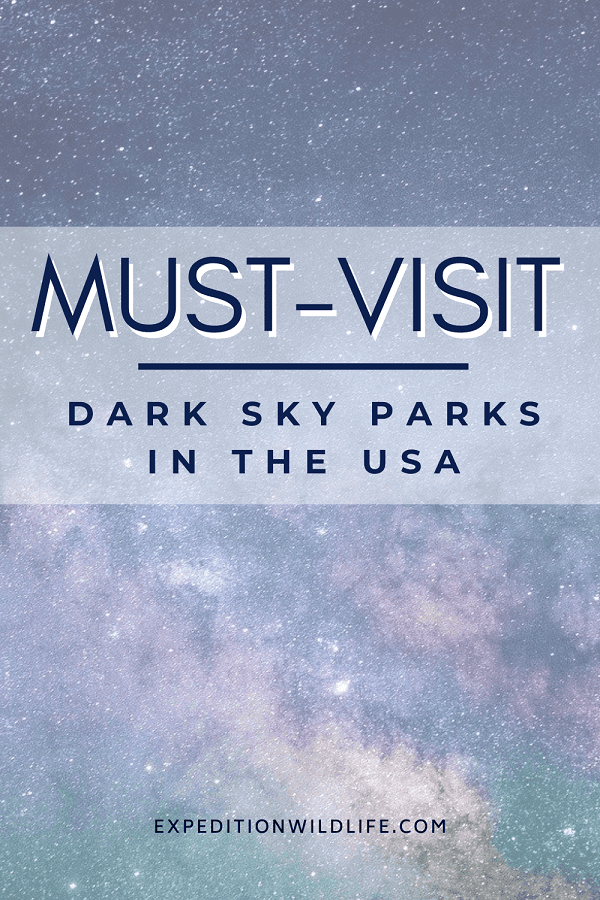

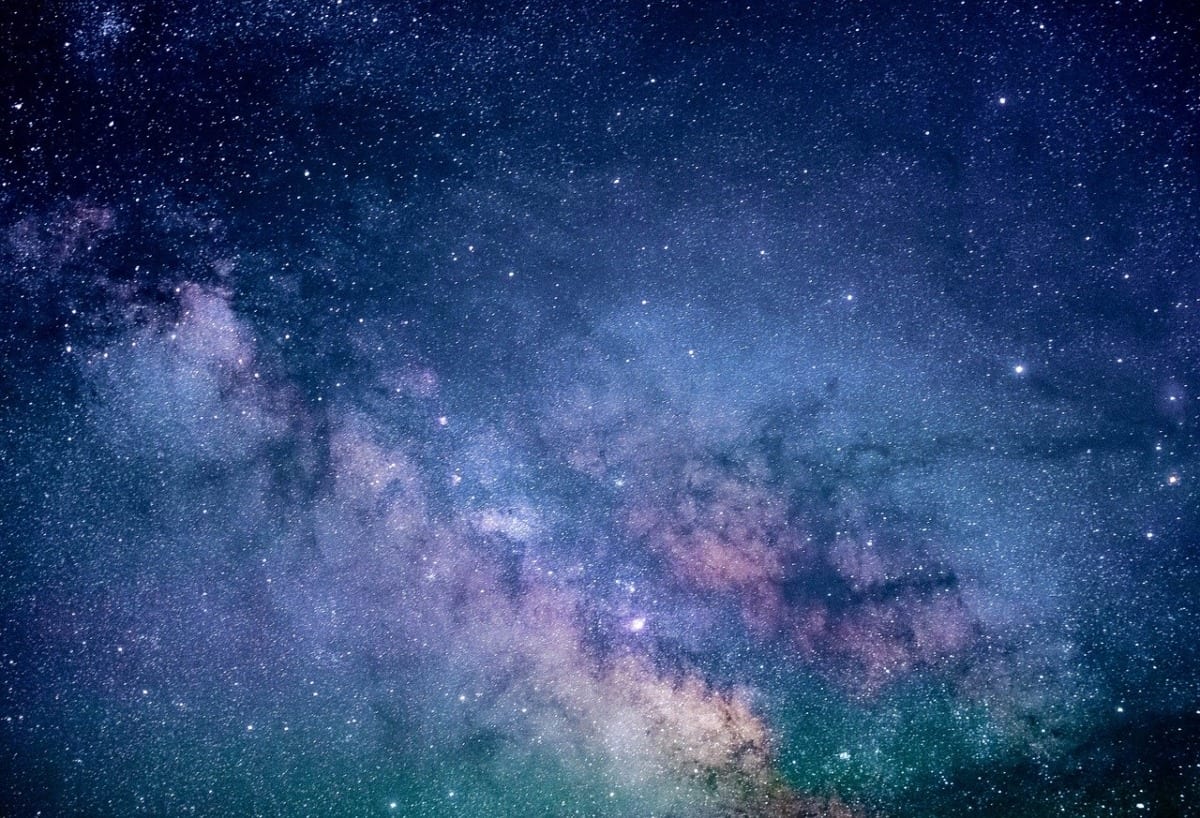
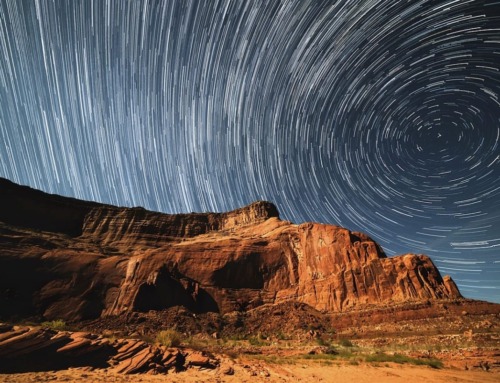
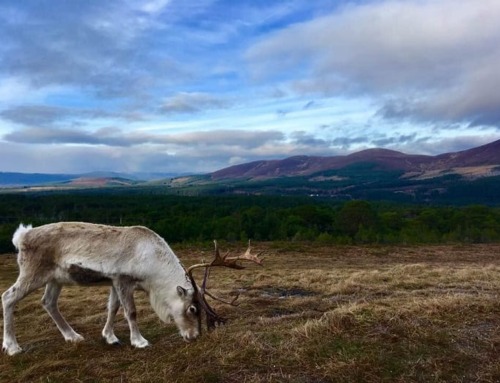
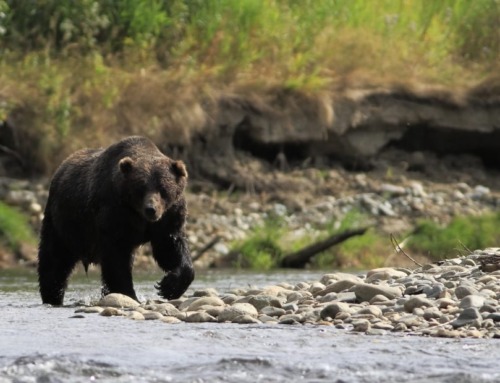
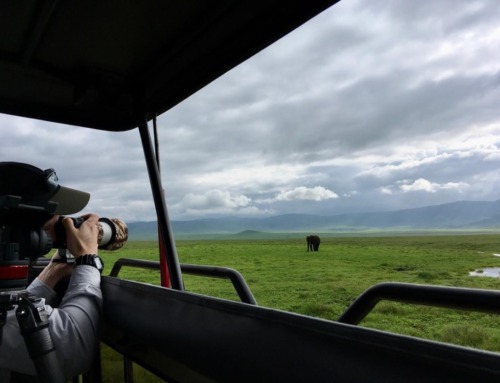
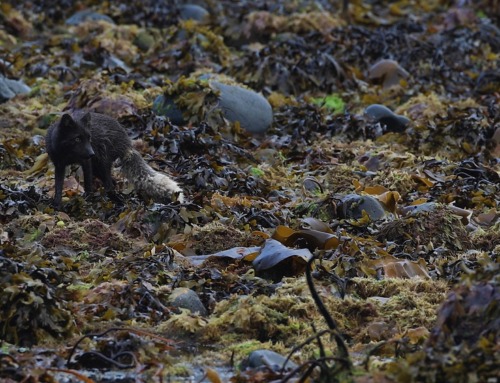
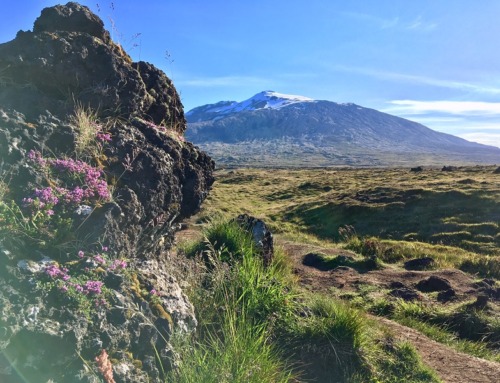
Leave A Comment